Looking at New Americans
Photographer Mark Chester had his eye on the U.S. census of 2010, curious about the diverse range of nationalities represented in Massachusetts. He found inspiration for a photography project in the data and eventually photographed foreign-born residents of the Commonwealth who were from more than 190 countries and became naturalized citizens.
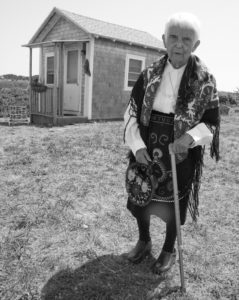
A selection of these photographs is on view in “The Bay State: A Multicultural Landscape; Photographs of New Americans” at the Eastham Public Library. Chester will discuss his work with immigration attorney Stephanie Souza at an opening reception on Saturday, Nov. 5 from 3 to 5 p.m.
One of his first photographs for the project was of Maria Dias, who was born in Portugal and lived in Truro until her death in 2019 at age 103. Chester met her at the Blessing of the Fleet in Provincetown in 2011. “I walked along with her during a procession from the church to the harbor,” he says. “She was wearing her Portuguese attire. She looked fantastic, and she accepted my offer of a photograph.”
Chester first started taking photographs as a Peace Corps volunteer in the Kingdom of Tonga in 1968. “I’ve always had wanderlust,” he says. He continued to explore the world as an editorial photographer. Although his project has been fully situated in Massachusetts, Chester feels it satisfies his desire to travel: “I’ve been traveling around the world without leaving the state.” He often meets the immigrants he photographs at citizenship ceremonies. “It’s not only my project, but also the project of the participants,” he says. “I’m beholden to them and so grateful.” —Abraham Storer
The Hoppers at PAAM
The Provincetown Art Association and Museum is exhibiting a collection of drawings and other material by Josephine and Edward Hopper. On view until Jan. 15, 2023, the show is concurrent with a large-scale Edward Hopper exhibition at the Whitney Museum of Art in New York City. The Hoppers owned a home in Truro where they lived for many years.
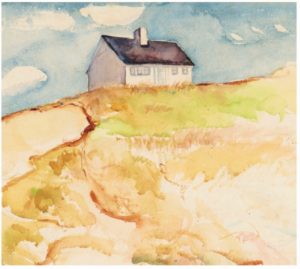
The contents of the PAAM exhibition were chosen to reflect some of the works in the Whitney show. These consist mainly of sketches for potential paintings, offering a unique insight into Hopper’s artistic process. “You can see how a line became a couch, that then became two people sitting on a couch,” said PAAM CEO Christine McCarthy, who curated the show, of one of the drawings. (McCarthy is featured prominently in a new documentary about the artists titled Hopper: An American Love Story.)
The exhibition at the Whitney was the subject of a recent article in the New York Times questioning the provenance and true ownership of some the works on display. “It would take an act of resurrection to unravel the mystery, because the only people who really knew are dead,” said McCarthy of the article. In any case, she said, she is unconcerned with the controversy. “The collection was supposed to go to the Whitney, and it’s at the Whitney, so in the end it’s where it ought to be,” she said. (According to PAAM’s website, most of the Hoppers in PAAM’s collection came from a 2016 donation by Laurence C. and J. Anton Schiffenhaus in honor of their mother, Mary Schiffenhaus, a close friend of Josephine and Edward Hopper, and two anonymous donors.)
A selection of correspondence between the Hoppers and their social circle, along with archival material and other ephemera, are also on display. More information on the collection and current exhibition can be found on the PAAM website. —James Judd
Celebrating 50 Years of ‘Unusual and Urgent’ Writing
AGNI, the Boston University-based literary journal named after the Vedic god of fire, is strongly entwined with the Outer Cape. Its founder, Askold Melnyczuk, read from his recent collection of stories at the Wellfleet library in August. Several of its writers and editors have been associated with the Fine Arts Work Center. Former FAWC fellow Sara Majka publishes fiction in AGNI; her most recent story takes place on the Cape.
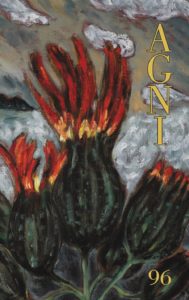
Two weeks ago, the magazine published an essay by Eileen Myles called “A Walk on Cape Cod.” And Sharon Dunn, who spends her summers in Wellfleet and edited the magazine for a decade in the 1970s and ’80s, published An Island in Time — a book about Bound Brook Island in Wellfleet — earlier this year. “It’s wonderful to be part of something that’s had such a long life,” said Dunn.
The magazine will celebrate its 50th anniversary on Nov. 4 with an event at CitySpace (890 Commonwealth Ave., Boston) that will stream at agnionline.bu.edu.
William Pierce, the current co-editor of AGNI, noted that seven of the magazine’s writers have gone on to win Nobel Prizes. “It’s a detail we love to trot out because it’s almost unbelievable,” said Pierce. The magazine gets about 16,000 submissions annually, of which about half of one percent make it into the biannual publication. Pierce added that AGNI prioritizes writing that is “unusual and urgent.”
While the celebration could have been a gala, AGNI chose to prioritize affordability over raising money, said Pierce. “We’re doing it to point out to people in Massachusetts that we have one of the country’s literary jewels here,” he said, “and we should all celebrate it together.” —Sophie Mann-Shafir
Sara Stern’s Sunset Reflections
The sun had just touched the horizon in a band of brilliant orange sky when about three dozen people gathered in a corner of the Herring Cove parking lot. Bundled against the late October chill, they made their way along a lit path to a clearing on the beach where the slope of the dunes created a natural amphitheater and settled in with blankets and a few whistles in case any coyotes happened upon the scene.
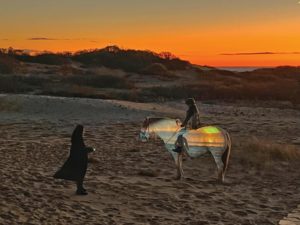
The coyotes never showed up. But the horses did.
The Oct. 27 event was a presentation of Sara Stern’s Mirror Ball (a rehearsal in the dunes), a multimedia performance piece that Stern, the current Pace Resident Artist Fellow at the Fine Arts Work Center, said incorporated threads from several intersecting projects she has been working on. Stern was assisted by fellow artists who wielded five portable video projectors that created skittering images across the sand. Sound artist Sam Sewell accompanied the piece with a shifting dronelike sound design via a laptop and singing bowls.
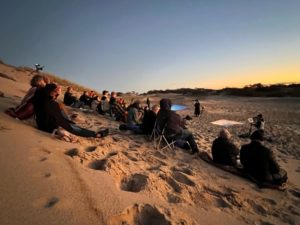
Wearing metallic silver face paint dotted with sequins, Stern narrated the rehearsal with a microphone, describing the outline of a “queer Western” story that spanned the pre-gentrification West Side of Manhattan and the wetlands of Provincetown. Stop-motion video footage of animated figures and mirrored disco balls rolling across the beach — which Stern filmed in the dunes over the last several months — stretched over the ground, their perspectives skewed and elongated by collaborators holding the video projectors in different positions.
Suddenly, the soundtrack switched to an excerpt from Ennio Morricone’s score for The Good, the Bad, and the Ugly as two riders on horseback swept into the tableau, their headlamps transforming them into surreal apparitions. The horses became living, moving canvases as Stern’s videos were projected on their sides, while the sky grew darker as the sun slipped below the edge of the ocean.
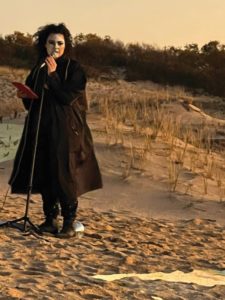
And then it was over. The horses stepped away from the sandy stage, breaking into a gallop as they approached the path out of the dunes. One by one, the video projectors were turned off. “That’s it. Thank you all for coming,” said Stern, as the last light disappeared below the horizon and the audience began walking back to the parking lot. —John D’Addario



